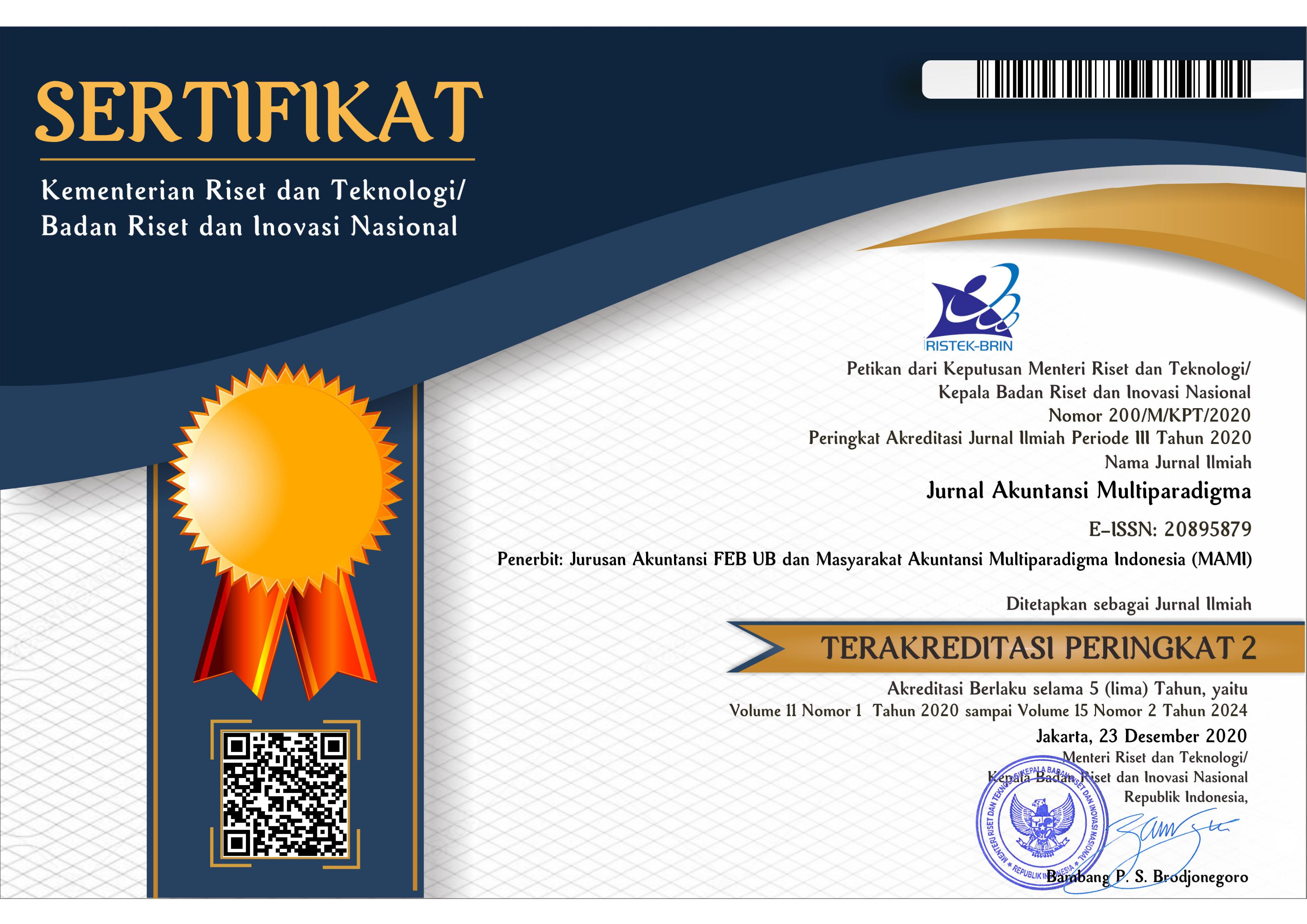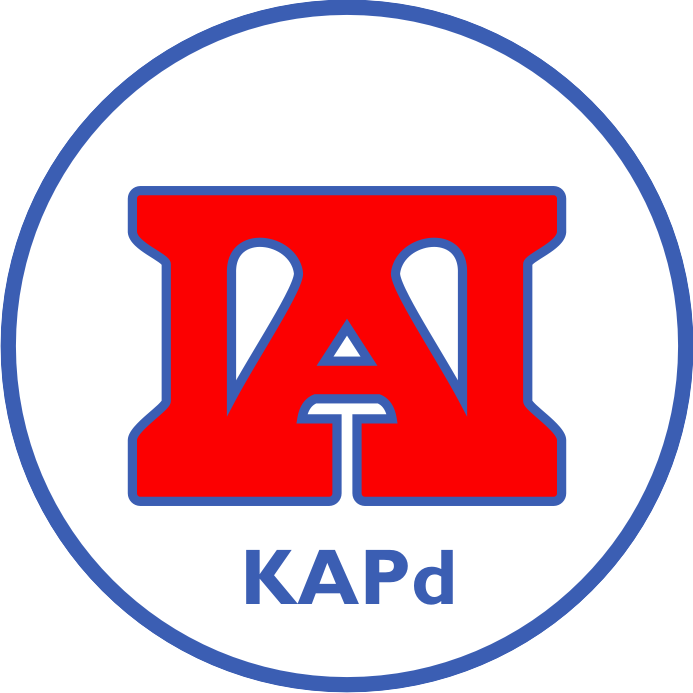RANTAI NILAI PADA AUDIT SEKTOR PUBLIK
Abstract
Abstrak: Rantai Nilai pada Audit Sektor Publik. Penelitian ini bertujuan untuk menentukan pemetaan dan penerapan rantai nilai audit pada Inspektorat Jenderal Kementerian Keuangan. Peneliti menggunakan metode studi eksploratif, yang didasarkan atas pengamatan, wawancara, dan telaah teoretis. Penelitian ini menunjukkan bahwa proses bisnis audit dapat dipetakan dalam kerangka rantai nilai dilihat dari sisi aktivitas utama maupun aktivitas pendukung. Selain itu, penerapannya memberikan nilai tambah bagi pengguna. Namun, peneliti masih menemukan kelemahan dalam penerapan konsep rantai nilai, yaitu proses bisnis yang belum dituangkan dalam format baku, seperti Standar Operasional Prosedur.
Abstract: The Value Chain on Public Sector Auditing. This study aims to determine the mapping and application of the auditing value chain at the General Inspectorate of the Ministry of Finance. Researchers use exploratory study method, which is based on observations, interviews, and theoretical studies. This study shows that the audit business process can be mapped in the value chain framework seen from the main and supporting activities. In addition, its application provides value added to users. However, the researchers still find the weaknesses in its application, namely that business processes that have not been set forth in standard formats, such as Standard Operating Procedures.
Keywords
Full Text:
PDFReferences
Andhayani, A. (2017). Dilema Akrualisasi Akuntansi dalam Pengelolaan Keuangan Daerah. Jurnal Akuntansi Multiparadigma, 8(2), 291-307. https://doi.org/10.18202/jamal.2017.08.7055
Agnihotri, A. (2014). The Role of the Upper Echelon in the Value Chain Management. Competitiveness Review, 24(3), 240-255. https://doi.org/10.1108/CR-05-2013-0049
Aloini, D., Dulmin, R., Mininno, V., & Ponticelli, S. (2013). Project-service Solutions in the Yacht Industry: A Value-Chain Analysis. International Journal of Engineering Business Management, 52(5), 1-12. https://doi.org/10.5772/57331
Arena, M. (2013). Internal Audit in Italian Universities: An Empirical Study. Procedia - Social and Behavioral Sciences, 93, 2000-2005. https://doi.org/10.1016/j.sbspro.2013.10.155
Birrell, D. (2012). Policy Copying and Public Sector Reform in Northern Ireland. Regional & Federal Studies, 22(3), 309-321. https://doi.org/10.1080/13597566.2012.688273
Biswan, A. T., & Wardani, F. (2017). Implementasi Just-in-Time Layanan Penerbitan Nomor Pokok Wajib Pajak. Jurnal Akuntansi Multiparadigma, 8(2), 353-369. https://Sdoi.org/10.18202/jamal.2017.08.7059
Chandra, Y., & Shang, L. (2017). An RQDA-based Constructivist Methodology for Qualitative Research. Qualitative Market Research: An International Journal, 20(1), 90-112. https://doi.org/10.1108/QMR-02-2016-0014
Clarke, K., Flanagan, J., & O'Neill, S. (2008). The Financial Information Value Chain: Repositioning Accounting Knowledge. Australasian Accounting, Business and Finance Journal, 2(1), 82-94.
Coetzee, P. (2016). Contribution of Internal Auditing to Risk Management: Perceptions of Public Sector Senior Management. International Journal of Public Sector Management, 29(4), 348-364. https://doi.org/10.1108/IJPSM-12-2015-0215
Darsiharjo, D., & Galihkusumah, A. H. (2016). Analisis Rantai Nilai Industri Kreatif di Desa Wisata Jelekong Kabupaten Bandung. Jurnal Manajemen Resort dan Leisure, 11(1), 35–41. https://doi.org/10.17509/jurel.v11i1.2900
Djamhuri, A., & Amirya, M. (2015). Indonesian Hospital under the “BPJS” Scheme: A War in a Narrower Battlefield. Jurnal Akuntansi Multiparadigma, 6(3), 341-349. https://doi.org/10.18202/jamal.2015.12.6027
Enquist, B., Camén, C., & Johnson, M. (2011). Contractual Governance for Public Service Value Networks. Journal of Service Management, 22(2), 217-240. https://doi.org/10.1108/09564231111124235
Esko, S., Zeromskis, M., & Hsuan, J. (2013). Value Chain and Innovation at the Base of the Pyramid. South Asian Journal of Global Business Research, 2(2), 230-250. https://doi.org/10.1108/SAJGBR-03-2012-0020
Fahlevi, H. (2016). Understanding Why the Role of Accounting is Unchanged in Indonesian Public Hospitals. Journal of Accounting & Organizational Change, 12(3), 203-222. https://doi.org/10.1108/JAOC-03-2014-0020
Fearne, A., Martinez, M. G., & Dent, B. (2012). Dimensions of Sustainable Value Chains: Implications for Value Chain Analysis. Supply Chain Management: An International Journal, 17(6), 575-581. https://doi.org/10.1108/13598541211269193
Fitri, F., & Indriani, M. (2011). Perencanaan dan Penganggaran Pemerintah Daerah Otonomi Khusus Ditinjau dari Aspek Keprilakuan. Jurnal Akuntansi Multiparadigma, 2(1), 22-34. https://doi.org/10.18202/jamal.2011.04.7108
Harnesk, D., Brogaard, S., & Peck, P. (2017). Regulating a Global Value Chain with the European Union's Sustainability Criteria – Experiences from the Swedish Liquid Transport Biofuel Sector. Journal of Cleaner Production, 153, 580-591. https://doi.org/10.1016/j.jclepro.2015.09.039
Heintzman, R., & Marson, B. (2005). People, Service and Trust: Is There a public Sector Service Value Chain? International Review of Administrative Sciences, 71(4), 549–575. https://doi.org/10.1177/0020852305059599
Hertog, C. D. (2014). Better Value Chains: A Matrix for Competitive Advantage. Journal of Business Strategy, 35(5), 43-48. https://doi.org/10.1108/JBS-04-2014-0042
Howieson, J., Lawley, M., & Hastings, K. (2016). Value Chain Analysis: An Iterative and Relational Approach for Agri-Food Chains. Supply Chain Management: An International Journal, 21(3), 352-362. https://doi.org/10.1108/SCM-06-2015-0220
Hutaibat, K. A. (2011). Value Chain for Strategic Management Accounting in Higher Education. International Journal of Business and Management, 6(11), 206–218. https://doi.org/10.5539/ijbm.v6n11p206
Institute of Internal Auditors Research Foundation. (2009). Internal Audit Capability Model for the Public Sector. Tersedia pada: https://na.theiia.org/iiarf/Public Documents/Internal Audit Capability Model IA-CM for the Public Sector Overview.pdf (Diakses: 22 Januari 2018).
Iraswari, I., & Adam, H. (2012). Lean Manufacturing Implementation: An Approach to Reduce Production Cost. Jurnal Akuntansi Multiparadigma, 3(1), 58-70. https://doi.org/10.18202/jamal.2012.04.7144
Jenni, N. N., & Outi, U. (2013). Identifying Potential Sources of Value in a Packaging Value Chain. Journal of Business & Industrial Marketing, 28(2), 76-85. https://doi.org/10.1108/08858621311295227
Jesus, M. A. J., & Eirado, J. S. B. (2012). Relevance of Accounting Information to Public Sector Accountability: A Study of Brazilian Federal Public Universities. Tékhne, 10(2), 87-98. https://doi.org/10.1016/j.tekhne.2012.10.001
Lee, C., & Yun, M. (2018). Accounting of Gross Exports and Tracing Foreign Values in the Global Pharmaceutical Value Chain: Where does Korea Stand? Journal of Korea Trade, 22(4), 48-363. https://doi.org/10.1108/JKT-02-2018-0008
Linqing, L., Liwen, T., & Haiyan, M. (2011). Two‐Dimensional Governances and industrial International Competitiveness. Nankai Business Review International, 2(3), 325–344. https://doi.org/10.1108/20408741111155325
Lorentz, H., Solakivi, T., Töyli, J., & Ojala, L. (2016). Trade Credit Dynamics during the Phases of the Business Cycle – A Value Chain Perspective. Supply Chain Management: An International Journal, 21(3), 363-380. https://doi.org/10.1108/SCM-08-2015-0307
McColl, J., & Moore, C. (2014). Developing and Testing a Value Chain for Fashion Retailers: Activities for Competitive Success. The Journal of The Textile Institute, 105(2), 136-149. https://doi.org/10.1080/00405000.2013.829934
Miles, M. B., Huberman, A. M., & Saldaäna, J. (2014). Qualitative Data Analysis: A Methods Sourcebook (3rd ed.). Califorinia: SAGE Publications.
Ming, L. T. (2011). Value Chain Flexibility with RFID: A Case Study of the Octopus Card. International Journal of Engineering Business Management, 3(1), 44-49. https://doi.org/10.5772/45673
Mir, M., Fan, H., & Maclean, I. (2017). Public Sector Audit in the Absence of Political Competition. Managerial Auditing Journal, 32(9), 899-923. https://doi.org/10.1108/MAJ-03-2016-1357
Mol, A. P. J. (2015). Transparency and Value Chain Sustainability. Journal of Cleaner Production, 107, 154-161. https://doi.org/10.1016/j.jclepro.2013.11.012
Mu, L., & Cui, X. (2012). An Experimental Research on Governance Mechanisms for Cost of Value Chain. Nankai Business Review International, 3(2), 199–218. https://doi.org/10.1108/20408741211244479
Mutiganda, J. C. (2014). Circuits of Power and Accountability during Institutionalisation of Competitive Tendering in Public Sector Organisations: A Field Study in Public Care of the Elderly. Qualitative Research in Accounting & Management, 11(2), 129-145. https://doi.org/10.1108/QRAM-04-2014-0034
Nadvi, K. and Raj‐Reichert, G. (2015), Governing Health and Safety at Lower Tiers of the Computer Industry Global Value Chain. Regulation & Governance, 9(3), 243-258. https://doi.org/10.1111/rego.12079
Ndyetabula, D. W., Sørensen, O. J., & Temu, A. A. (2016). Agribusiness Development and the Role of Value Chain Business Associations: The Case of Dried Fruits and Vegetables in Tanzania. African Journal of Economic and Management Studies, 7(4), 510-534. https://doi.org/10.1108/AJEMS-01-2014-0005
Pathak, V., & Pathak, K. (2010). Reconfiguring the Higher Education Value Chain. Management in Education, 24(4), 166–171. https://doi.org/10.1177/0892020610376791
Qu, S. Q., & Dumay, J. (2011). The Qualitative Research Interview. Qualitative Research in Accounting & Management, 8(3), 238-264. https://doi.org/10.1108/11766091111162070
Rathee, R., & Rajain, P. (2013). Service Value Chain Models in Higher Education. International Journal of Emerging Research in Management & Technology, 2(7), 1-6.
Rawlins, J. M., Lange, W. J. D., & Fraser, C. C. G. (2018). An Ecosystem Service Value Chain Analysis Framework: A Conceptual Paper. Ecological Economics, 147, 84-95. https://doi.org/10.1016/j.ecolecon.2017.12.023
Sareen, S. (2017). Who Governs Local Access in Jharkhand? Mechanisms of Access to Government Services. Forum for Development Studies, 44(2), 249-274. https://doi.org/10.1080/08039410.2016.1233135
Scannella, E. (2015). What Drives the Disintegration of the Loan Origination Value Chain in the Banking Business. Business Process Management Journal, 21(2), 288-311. https://doi.org/10.1108/BPMJ-02-2014-0017
Serrano, M. J. H., Greenhill, A., & Graham, G. (2015). Transforming the News Value Chain in the Social Era: A Community Perspective. Supply Chain Management: An International Journal, 20(3), 313-326. https://doi.org/10.1108/SCM-05-2014-0147
Tammel, K. (2017). Shared Services and Cost Reduction Motive in the Public Sector. International Journal of Public Administration, 40(9), 792-804. https://doi.org/10.1080/01900692.2016.1204617
Theyel, N. (2013). Extending Open Innovation throughout the Value Chain by Small and Medium-Sized Manufacturers. International Small Business Journal, 31(3), 256–274. https://doi.org/10.1177/0266242612458517
Tosida, E. T., Thaheer, H., & Maryana, S. (2015). Strategi Peningkatan Daya Saing Melalui Framework Rantai Nilai untuk Kompetensi Usaha Jasa Telematika Indonesia. Jurnal Penelitian Pos dan Informatika, 5(1), 1–18. https://doi.org/10.17933/jppi.2015.0501001
Verbeke, A., & Yuan, W. (2016). The Impact of “Distance” on Multinational Enterprise Subsidiary Capabilities: A Value Chain Perspective. Multinational Business Review, 24(2), 168-190. https://doi.org/10.1108/MBR-05-2015-0021
Waal, A. D., Orij, R., Rosman, J., & Zevenbergen, M. (2014). Applicability of the High-Performance Organization Framework in the Diamond Industry Value Chain. Journal of Strategy and Management, 7(1), 30-48. https://doi.org/10.1108/JSMA-05-2013-0029
Waldt, G. V. D. (2016). From Policy to Projects: A Public Service Value-Chain Network Model. Journal of Social Sciences, 49(1-2), 145-157. https://doi.org/10.1080/09718923.2016.11893607
Watabaji, M., Molnar, A., and Gellynck, X. (2016) Integrative Role of Value Chain Governance: Evidence from the Malt Barley Value Chain in Ethiopia. Journal of The Institute of Brewing, 122(4), 670–681. https://doi.org/10.1002/jib.378.
DOI: http://dx.doi.org/10.18202/jamal.2018.04.9017
Refbacks
- There are currently no refbacks.
Copyright (c) 2018 Ali Tafriji Biswan, Emir Fahreza Zarnedi

This work is licensed under a Creative Commons Attribution-NonCommercial 4.0 International License.

















